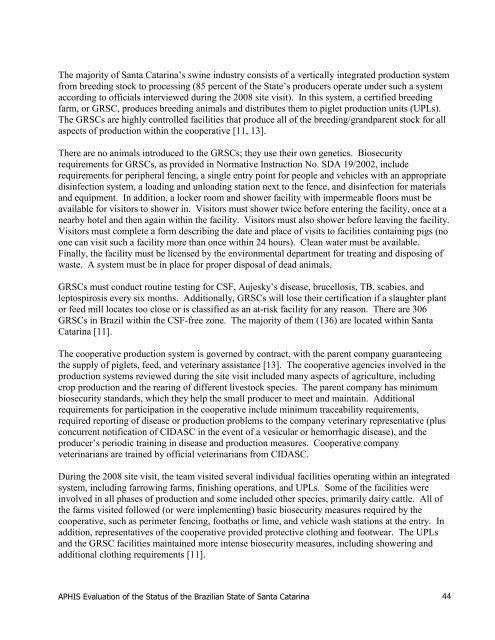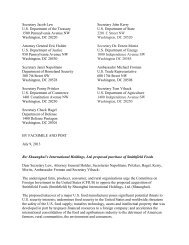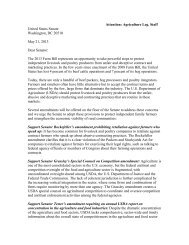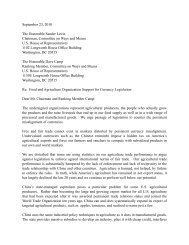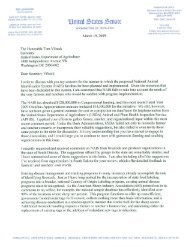Exhibit 8, 100416 Brazil FMD Risk Evaluation - R-Calf
Exhibit 8, 100416 Brazil FMD Risk Evaluation - R-Calf
Exhibit 8, 100416 Brazil FMD Risk Evaluation - R-Calf
Create successful ePaper yourself
Turn your PDF publications into a flip-book with our unique Google optimized e-Paper software.
The majority of Santa Catarina’s swine industry consists of a vertically integrated production system<br />
from breeding stock to processing (85 percent of the State’s producers operate under such a system<br />
according to officials interviewed during the 2008 site visit). In this system, a certified breeding<br />
farm, or GRSC, produces breeding animals and distributes them to piglet production units (UPLs).<br />
The GRSCs are highly controlled facilities that produce all of the breeding/grandparent stock for all<br />
aspects of production within the cooperative [11, 13].<br />
There are no animals introduced to the GRSCs; they use their own genetics. Biosecurity<br />
requirements for GRSCs, as provided in Normative Instruction No. SDA 19/2002, include<br />
requirements for peripheral fencing, a single entry point for people and vehicles with an appropriate<br />
disinfection system, a loading and unloading station next to the fence, and disinfection for materials<br />
and equipment. In addition, a locker room and shower facility with impermeable floors must be<br />
available for visitors to shower in. Visitors must shower twice before entering the facility, once at a<br />
nearby hotel and then again within the facility. Visitors must also shower before leaving the facility.<br />
Visitors must complete a form describing the date and place of visits to facilities containing pigs (no<br />
one can visit such a facility more than once within 24 hours). Clean water must be available.<br />
Finally, the facility must be licensed by the environmental department for treating and disposing of<br />
waste. A system must be in place for proper disposal of dead animals.<br />
GRSCs must conduct routine testing for CSF, Aujesky’s disease, brucellosis, TB, scabies, and<br />
leptospirosis every six months. Additionally, GRSCs will lose their certification if a slaughter plant<br />
or feed mill locates too close or is classified as an at-risk facility for any reason. There are 306<br />
GRSCs in <strong>Brazil</strong> within the CSF-free zone. The majority of them (136) are located within Santa<br />
Catarina [11].<br />
The cooperative production system is governed by contract, with the parent company guaranteeing<br />
the supply of piglets, feed, and veterinary assistance [13]. The cooperative agencies involved in the<br />
production systems reviewed during the site visit included many aspects of agriculture, including<br />
crop production and the rearing of different livestock species. The parent company has minimum<br />
biosecurity standards, which they help the small producer to meet and maintain. Additional<br />
requirements for participation in the cooperative include minimum traceability requirements,<br />
required reporting of disease or production problems to the company veterinary representative (plus<br />
concurrent notification of CIDASC in the event of a vesicular or hemorrhagic disease), and the<br />
producer’s periodic training in disease and production measures. Cooperative company<br />
veterinarians are trained by official veterinarians from CIDASC.<br />
During the 2008 site visit, the team visited several individual facilities operating within an integrated<br />
system, including farrowing farms, finishing operations, and UPLs. Some of the facilities were<br />
involved in all phases of production and some included other species, primarily dairy cattle. All of<br />
the farms visited followed (or were implementing) basic biosecurity measures required by the<br />
cooperative, such as perimeter fencing, footbaths or lime, and vehicle wash stations at the entry. In<br />
addition, representatives of the cooperative provided protective clothing and footwear. The UPLs<br />
and the GRSC facilities maintained more intense biosecurity measures, including showering and<br />
additional clothing requirements [11].<br />
APHIS <strong>Evaluation</strong> of the Status of the <strong>Brazil</strong>ian State of Santa Catarina 44


